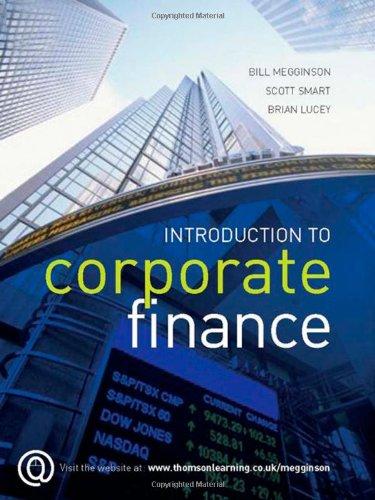Question
1) A firm is starting a new project that will cost $200,000. It is projected to last 5 years and to generate cash flows of
1) A firm is starting a new project that will cost $200,000. It is projected to last 5 years and to generate cash flows of $50,000, $70,000, $90,000, $50,000 and $30,000 from Years 1 through 5 respectively. If the discount rate is 10%, what is the payback period of this project? Round to the second decimal place. Type only numbers without any unit ($, %, etc.)
2)A firm is starting a new project that will cost $200,000. It is projected to last 5 years and to generate cash flows of $50,000, $70,000, $90,000, $50,000 and $30,000 from Years 1 through 5 respectively. If the discount rate is 10%, what is the PI of this project? Round to the second decimal place. Type only numbers without any unit ($, %, etc.)
3) Initial Outlay $50 million
Year 1 $10 million
Year 2 $20 million
Year 3 $20 million
Year 4 $10 million
Year 5 $5 million
The required rate of return is 15%. What is the NPV of the project? Round to the near hundredth million. Do not include any unit such as $, %, etc. (i.e. if your answer were -$1.23 million, type in -1.23 as your answer without $ and million) If there are multiple answers, then type NA.
4)A firm is starting a new project that will cost $200,000. It is projected to last 5 years and to generate cash flows of $50,000, $70,000, $90,000, $50,000 and $30,000 from Years 1 through 5 respectively. If the discount rate is 10%, what is the IRR of this project? Answer in the percent format. Round to the hundredth decimal place. Type only numbers without any unit ($, %, etc.)
5)A firm is starting a new project that will cost $200,000. It is projected to last 5 years and to generate cash flows of $50,000, $70,000, $90,000, $50,000 and $30,000 from Years 1 through 5 respectively. If the discount rate is 10%, what is the EAA of this project? Round to the nearest penny. Do not include any unit such as $, %, etc.
6)You are trying to determine which of two none mutually exclusive projects to undertake. Project Adam has an initial outlay of $10,000, an NPV of $4,392.15, an IRR of 11.33%, and an EAA of $1,158.64. Project Eve has an initial outlay of $15,000, an NPV of $5,833.73, an IRR of 9.88%, and an EAA of $1,093.50. The cost of capital for both projects is 10%, and the projects have different lives. If the projects are not repeatable, then:
| You should do both projects because they have positive NPVs. You should do Project Adam because it has a higher EAA. You should do Project Eve because it has a higher NPV. You should do Project Adam because it has a higher IRR. You should do neither projects since neither of them adds value to you. 7)Use the following information to answer next three questions: IO PI IRR LIFE Project 1 $300,000 1.12 14.38% 15 years Project 2 $150,000 1.08 13.32% 6 years Project 3 $100,000 1.20 16.46% 3 years Assume that the cost of capital is 12%.
If the firm has a maximum capital expenditures budget of $450,000, and if the projects are mutually exclusive, and repeatable, which project(s) should be accepted?
|
Step by Step Solution
There are 3 Steps involved in it
Step: 1

Get Instant Access to Expert-Tailored Solutions
See step-by-step solutions with expert insights and AI powered tools for academic success
Step: 2

Step: 3

Ace Your Homework with AI
Get the answers you need in no time with our AI-driven, step-by-step assistance
Get Started


